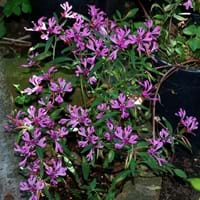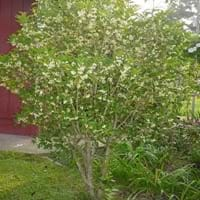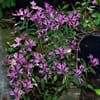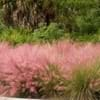Life Span
Annual
Perennial
Type
Flowering Plants
Broadleaf Evergreen
Origin
United States, California
Asia, Nepal, China, Japan, Korea
Types
Santa Clara red ribbons, red ribbons, Raiche's red ribbons
Apricot Gold, Butter Yellow, Orange Supreme, Dan
Number of Varieties
Not Available
Habitat
Dry areas, foothill woods
Dappled Shade, Woodland Garden Canopy
USDA Hardiness Zone
Not Available
6-11
AHS Heat Zone
9 - 1
12 - 8
Sunset Zone
A3, 1a, 1b, 2a, 2b, 3a, 3b, 4, 5, 6, 7, 8, 9, 10, 11, 12, 13, 14, 15, 16, 17, 18, 19, 20, 21, 22, 23, 24
21,22
Habit
Clump-Forming
Upright/Erect
Flower Color
Pink, Fuchsia, Rose, Lavender
White, Orange
Flower Color Modifier
Bicolor
Bicolor
Fruit Color
Not Available
Blue, Black
Leaf Color in Spring
Green, Gray Green
Green, Dark Green
Leaf Color in Summer
Green, Gray Green
Dark Green
Leaf Color in Fall
Green, Gray Green
Dark Green
Leaf Color in Winter
Light Green
Dark Green
Leaf Shape
Ovate
Oval, Finely Dentate
Plant Season
Spring, Summer
Spring, Summer, Fall, Winter
Sunlight
Partial Sun, Partial shade
Full Sun, Partial Sun, Partial shade
Type of Soil
Loam, Sand
Clay, Loam, Sand
The pH of Soil
Neutral
Acidic, Neutral
Soil Drainage
Well drained
Well drained
Bloom Time
Spring, Late Spring, Early Summer, Summer
Spring, Late Spring, Early Fall, Fall
Tolerances
Not Available
Not Available
Where to Plant?
Container, Ground, Pot
Container, Ground, Pot
How to Plant?
Seedlings, Stem Planting
Semi-hardwood cuttings
Plant Maintenance
Medium
Medium
Watering Requirements
Allow to dry out slightly between watering
Average Water Needs
In Summer
Lots of watering
Lots of watering
In Spring
Moderate
Moderate
In Winter
Average Water
Average Water
Soil pH
Neutral
Acidic, Neutral
Soil Type
Loam, Sand
Clay, Loam, Sand
Soil Drainage Capacity
Well drained
Well drained
Sun Exposure
Part sun, Partial shade
Full Sun, Partial Sun, Partial shade
Pruning
Remove damaged leaves, Remove dead branches, Remove dead leaves
Remove no more than one-third of each branch
Fertilizers
All-Purpose Liquid Fertilizer
All-purpose dry fertilizer
Pests and Diseases
Red blotch
No serious insect or disease problems
Plant Tolerance
Drought
Drought
Flower Petal Number
Single
Single
Showy Foliage
Not Available
No
Foliage Texture
Fine
Medium
Foliage Sheen
Matte
Glossy
Attracts
Butterflies
Nematodes
Allergy
Not Available
no allergic reactions
Aesthetic Uses
Showy Purposes
Beautification, Showy Purposes
Beauty Benefits
Not Available
Good for skin and hair
Environmental Uses
Air purification
Air purification
Medicinal Uses
Not Available
Antitussive
Part of Plant Used
Not Available
Bark, Flowers, Fruits, Stem
Other Uses
Used as Ornamental plant, Used for its medicinal properties
Used as essential oil, Used as insect repellent, Used in herbal medicines, Used in tea, wine and sweet dishes
Used As Indoor Plant
No
Yes
Used As Outdoor Plant
Yes
Yes
Garden Design
Bedding Plant, Showy Tree
Container, Feature Plant, Hedges, Houseplant, Mixed Border, Screening, Wind Break, Topiary, Bonsai, Espalier
Botanical Name
CLARKIA concinna
OSMANTHUS fragrans
Common Name
Red Ribbons
Sweet olive, Sweet osmanthus, Tea olive
In Hindi
Clarkia concinna
Sweet Olive
In German
Clarkia concinna
Sweet Olive
In French
Clarkia concinna
Olive douce
In Spanish
concinna clarkia
Oliva dulce
In Greek
Clarkia concinna
γλυκό Ελιά
In Portuguese
Clarkia concinna
Olive doce
In Polish
klarkia concinna
słodki Olive
In Latin
Clarkia concinna
Dulce Olive
Phylum
Tracheophyta
Magnoliophyta
Class
Magnoliopsida
Magnoliopsida
Order
Myrtales
Scrophulariales
Family
Onagraceae
Oleaceae
Clade
Angiosperms, Eudicots, Rosids
Angiosperms, Asterids, Eudicots
Tribe
Not Available
Oleeae
Subfamily
Not Available
Not Available
Number of Species
Not Available
Season and Care of Clarkia concinna and Sweet Olive
Season and care of Clarkia concinna and Sweet Olive is important to know. While considering everything about Clarkia concinna and Sweet Olive Care, growing season is an essential factor. Clarkia concinna season is Spring and Summer and Sweet Olive season is Spring and Summer. The type of soil for Clarkia concinna is Loam, Sand and for Sweet Olive is Clay, Loam, Sand while the PH of soil for Clarkia concinna is Neutral and for Sweet Olive is Acidic, Neutral.
Clarkia concinna and Sweet Olive Physical Information
Clarkia concinna and Sweet Olive physical information is very important for comparison. Clarkia concinna height is 25.40 cm and width 25.40 cm whereas Sweet Olive height is 30.00 cm and width 180.00 cm. The color specification of Clarkia concinna and Sweet Olive are as follows:
Clarkia concinna flower color: Pink, Fuchsia, Rose and Lavender
Clarkia concinna leaf color: Green and Gray Green
Sweet Olive flower color: White and Orange
- Sweet Olive leaf color: Green and Dark Green
Care of Clarkia concinna and Sweet Olive
Care of Clarkia concinna and Sweet Olive include pruning, fertilizers, watering etc. Clarkia concinna pruning is done Remove damaged leaves, Remove dead branches and Remove dead leaves and Sweet Olive pruning is done Remove no more than one-third of each branch. In summer Clarkia concinna needs Lots of watering and in winter, it needs Average Water. Whereas, in summer Sweet Olive needs Lots of watering and in winter, it needs Average Water.





